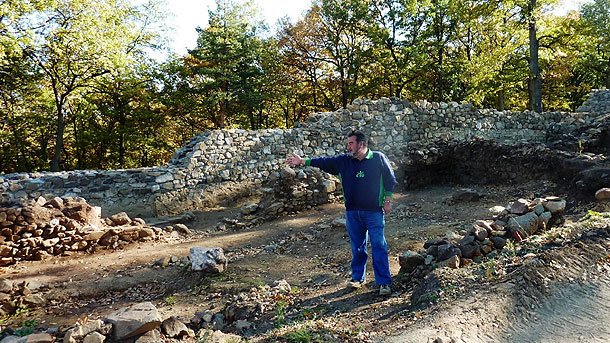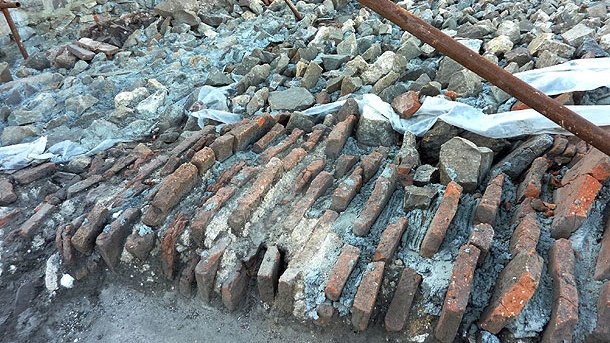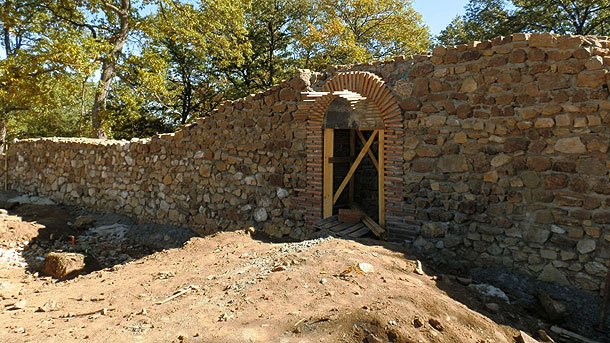On the top of the St. Spas hill near the Bulgarian village of Belchin, famous for its mineral water springs, an impressive fortress from Roman times can be seen. Until recently the fortress known as Tsari Mali Grad existed only in folklore legends. Archaeologists did not know its exact location but treasure hunters managed to find it. The hill was covered by a thick forest, archaeologist Veselin Hadzhiangelov says. “We came immediately after we found out treasure hunters were digging.” The site turned out to be a great find and in 2007 archaeologists managed to uncover a fortress tower, which is part of a Roman fortress, with a 400 m long wall.
Archaeologists were surprised again when they discovered Christian consecrated grounds near the village of Belchin. Such places in Bulgaria usually date back to the 15-16th century but the ones found here speak of 1700 years of continual Christianity.

© Photo: Maria Dimitrova-Pichot
“The earliest Christian temple here dates back to the end of the 3rd and the beginning of the 4th century. In the following centuries a church and a basilica were constructed. After the early church was destroyed another one that dates back to the 15th century was built. When it ceased to function the consecrated ground of St. Spas emerged. It turns out that we have 17centuries of Christianity here. We want to make this fact the characteristic feature of the region,” the archaeologist says.

© Photo: Maria Dimitrova-Pichot
Experts plan to clearly demonstrate the history of the region to tourists after partial reconstruction of all four Christian temples that used to exist here.
“We thought it would be best to show the temples as they existed throughout the ages. We know best the architecture of the church that dates back to the medieval period. That is why we are to reconstruct it completely. Next to the church we display the remains of the basilica dating back to the 6th century, where we discovered something interesting. It turned out the northern chapel was the place where Christenings took pace. It was in the end of the 5th century when the mass Christening of the Thracians here started. After the 6th century the big baptisteries disappeared, as the population was already mostly Christian. After that time baptismal fonts started to be used. Services in the church also changed and this had an effect on church architecture as a whole. We also have the northern half of the earliest Christian temple here preserved. There are also traces of a pagan sanctuary of unknown God, which will be also marked.”

© Photo: Maria Dimitrova-Pichot
The partial reconstruction of the early Christian temples has been almost finished. The medieval church can already be seen from the valley. The view that is revealed to tourists who reach the place is also a unique one.
Archaeologists told us that they could completely rebuild a major part of the antique fortress. Here is why:
“We had the unique chance to find structures that gave us enough information about the building. We found out that the two of the towers had tile roofs. We actually found some of the fallen roof, which showed us what the ancient construction looked like. Our biggest luck was that during an earthquake in the beginning of the 7th century, the northern wall of one of the towers fell down and we found it almost completely preserved. This wall showed us that it was a three-storey tower. We want to make a thorough reconstruction of the towers.”

© Photo: Maria Dimitrova-Pichot
For 5 or 6 months almost the whole fortress wall has been rebuilt. What was the purpose of the fortress? Archaeologists say the fortress served to protect the iron ore in the region. It is also situated on an ancient crossroads.
“I have discovered 8 similar fortresses in the Samokov valley. They served to protect the iron ore, which was of great strategic importance from invaders. In the fortress we even discovered a pile of iron bars, ready for export. What surprised us was that in the center of the fortress there were no buildings. Probably the central area protected by the walls was used to give shelter to the local population during frequent attacks in the 6th century, as tents were placed there.”

© Photo: Maria Dimitrova-Pichot
What were the most interesting archaeological finds in the region? We found great number of coins from the 4th to the 6th century. A rare coin dating back to the rule of Empress Galla Placidia was also discovered. Many weapons and arrows were found by archaeologists, too.
“We have found an arrow, which has a lead ball at the back end and was thrown by hand. This arrow was kept on the inside of the shield. Only officers of the army of Constantine The Great used to have such an arrow.”
A number of other artifacts and jewels were found too, including many artifacts of Goth origin. Goths used to be excellent metallurgists and that explains their presence in the region. All finds will be exhibited in the fortress towers in the near future. Archaeologists also want the fortress to be promoted to tourists by becoming a venue of various festivals and workshops. A new park will be build nearby too, in order to make the site even more attractive.

© Photo: Maria Dimitrova-Pichot
English version: Alexander Markov
In its centuries-old history, the Etropole Monastery "Holy Trinity", also called "Varovitets", has been preserving valuable pages decorated by skilled artists. Here hundreds of years ago, one of the most productive literary schools in Bulgarian..
Cape Kaliakra is one of the most picturesque places along Bulgaria’s Black Sea coast. The narrow rocky peninsula cuts 2 kilometers through the sea. Its steep slopes are 60-70 meters high. The waves have cut deep niches and caves..
As a result of glacial erosion during the Quaternary era, clusters of lakes were formed in the higher reaches of Rila Mountain, an essential element of the landscape. The string of the seven lakes of Rila is the longest, most scenic and most..

+359 2 9336 661
